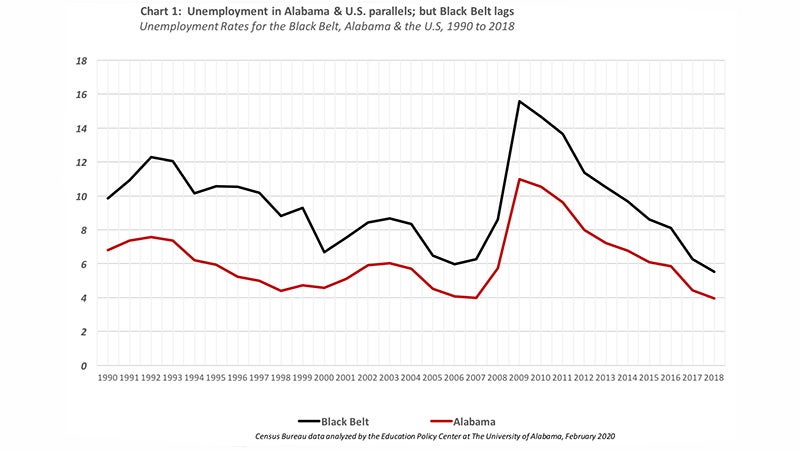Black Belt continues to face state’s highest jobless rates
Published 2:31 pm Tuesday, September 8, 2020
|
Getting your Trinity Audio player ready...
|
Over the past two weeks, the University of Alabama’s Education Policy Center (EPC) has explored the declines in population and school enrollment across the Black Belt as part of its series exploring the region’s various ongoing struggles.
The third installment focused on unemployment in the region and found that, while the Black Belt’s unemployment rate closely parallels that of the state, the region often sees numbers up to four percentage points higher.
During a brief press conference Tuesday morning, EPC Research Associate Hunter Whann noted that as of November 2019, the 18 counties suffering the state’s highest unemployment rates were all located in the Black Belt.
The three counties with the highest unemployment – Wilcox County, at 6.9 percent, Clarke County, at 5.9 percent, and Greene County, at 5.8 percent – saw unemployment rates double the statewide rate of 2.7 percent.
Even when the state sees improvement, the Black Belt does not enjoy the same progress.
“While every county in Alabama saw improved unemployment rates in 219 compared to 2018, Black Belt counties had a very different and higher starting point…,” an EPC press release stated. “Nationally, Alabama saw the largest percentage decline in its unemployment rate among all [50] states from November 2018 to November 2019. The Alabama statewide unemployment rate of 2.7 percent was [10th] lowest in the United States. This sparkling performance has not fully extended to the Black Belt, however.”
Despite the ominous nature of the data, help has been trickling in – Alabama Gov. Kay Ivey recently awarded over $1 million in grants to spur job growth in the Black Belt and Sumter County received $750,000 last month for infrastructure improvements, which follows a $600,000 grant to improve the Port of Epes.
According to EPC Director Stephen Katsinas, the COVID-19 pandemic has likewise disproportionately impacted the Black Belt, with 17 of the region’s 24 counties above the statewide unemployment average of 8.2 percent as of July.
“The region is struggling, but they’re not taking it sitting down,” Katsinas said, noting that the Black Belt could be in for a “long economic recovery” due to its outpacing of the state and nation in terms of unemployment levels.
Among those in the Black Belt rising to the occasion are the Black Belt Community Foundation (BBCF), which has distributed masks and resources throughout the pandemic and spearheaded a myriad of efforts before the outbreak, and the West Alabama Food Bank, which has distributed roughly 1.4 million pounds of food since mid-March.
Additionally, more than $4 million in federal assistance has come down for agencies that provide the region with “food, rent and medicine,” according to the EPC press release.
During Tuesday’s press conference, a number of prominent Black Belt voices were on the line to discuss what issues they have seen in their communities and how they have gone about addressing those issues.
For Thomasville Mayor Sheldon Day, a lack of widespread access to today’s technology, specifically high-speed broadband internet service, is one of the region’s biggest hurdles, an issue he said has “exacerbated problems [in the region] for generations.”
“We will never fully close that gap…but we must address the issue and allow it to enable us as small towns to take control of what we do have control over, which is making our education infrastructure better, making our healthcare infrastructure better,” Day said. “Many, many areas of the Black Belt don’t have that access. We’ve got to fix that issue.”
Day said the COVID-19 pandemic has put “a huge spotlight” on the connectivity issues plaguing the region, which impact community development, business recruitment, educational attainment and more.






